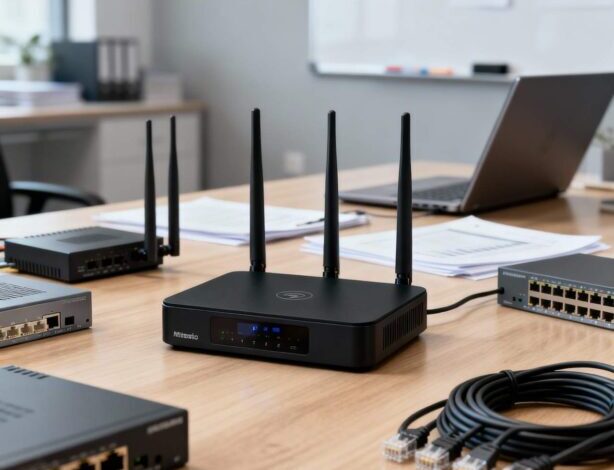How to Choose the Right Cellular Gateway for Your Business

Choosing the right cellular gateway is critical for any business that relies on consistent, secure, and high-speed internet connectivity. These devices play a vital role in bridging wired and wireless networks, especially in environments where traditional broadband is unreliable or unavailable. With the rise of remote operations, smart devices, and cloud services, demand for reliable cellular connectivity has surged. One option often evaluated in this space is MG fixed wireless access devices, which support LTE and 5G deployments across enterprise settings.
In this article, we’ll walk you through the key considerations for selecting a cellular gateway, so let’s start.
Evaluate Your Business Connectivity Needs
Before choosing any hardware, assess how your organization uses the internet. Consider the number of users, types of connected devices, and the nature of applications being used, such as cloud platforms, VoIP, surveillance, or industrial control systems.
If your primary location already has broadband but requires a backup connection, your needs differ from a remote construction site that depends entirely on LTE/5G. Some businesses require multiple SIMs or carrier failover. Others prioritize speed, while some need uptime guarantees in mission-critical environments. Begin with a detailed assessment of where the gateway will be used and what performance benchmarks are non-negotiable.
Understand Cellular Gateway Types
Cellular gateways come in a variety of form factors, each suited to different operating environments. Outdoor models are designed for harsh conditions and direct installation near antennas, while indoor gateways are compact and built for temperature-controlled spaces. There are also embedded modules designed for integration into other devices.
Gateways can also differ in connectivity capabilities. Some support only LTE, while others offer dual LTE/5G radios. Band support matters, especially if your carrier provides service on specific frequency ranges. Always match the device’s capabilities with your region and network provider’s infrastructure.
Prioritize Security and Remote Management
A gateway is a direct point of contact between your internal network and the public cellular infrastructure. That makes security a priority. Look for built-in VPN support, firewall configurations, and the ability to segment traffic by application or VLAN.
Remote management is equally essential. You need to monitor performance, troubleshoot faults, deploy firmware updates, and rotate credentials across a fleet of devices without sending IT staff onsite. Gateways that integrate with cloud management systems save time and reduce operational friction.
Assess Speed, Bandwidth, and Carrier Compatibility
Each business has unique performance demands. If your team streams video, runs VoIP, or uploads large files to the cloud, you’ll need higher data throughput. Entry-level gateways may support download speeds under 100 Mbps, while enterprise models offer multi-gigabit capabilities with 5G.
Don’t overlook upstream bandwidth either. In remote backup scenarios, upload speeds can be just as crucial. Review the gateway’s rated performance and confirm compatibility with your cellular provider. Some devices are locked to specific carriers or require manual APN configuration.
Power Redundancy and Failover Options
Power interruptions and connection failures can halt business operations. Many cellular gateways include failover features, switching from one carrier to another or falling back to broadband if the cellular link is down.
Battery backup, Power over Ethernet (PoE), or dual power inputs are features to look for in mission-critical applications. Redundancy doesn’t stop at connectivity, it should extend to power and configuration resilience.
Form Factor and Mounting Considerations
Not all gateways are created for the same environments. Will your unit be rack-mounted in a server room, attached to a DIN rail in a factory, or installed on a utility pole outdoors? Physical design, ingress protection (IP) ratings, and mounting hardware can all influence deployment success.
Outdoor gateways must withstand temperature fluctuations, humidity, dust, and even lightning. Industrial models are often hardened for vibration, whereas retail deployments might prioritize compact designs that blend into indoor setups.
Integration with Existing Network Infrastructure
Your cellular gateway must coexist with routers, switches, firewalls, and possibly SD-WAN or VPN appliances. Does it support the routing protocols your network uses? Can it be configured to act as a primary WAN or secondary backup?
Many enterprise gateways offer passthrough modes, bridge configurations, and traffic-shaping tools to control how data moves across your network. Some include Ethernet switch ports or Wi-Fi radios for all-in-one connectivity.
Cost of Ownership and Subscription Models
Cost includes more than the purchase price. Data plans, SIM fees, cloud management licensing, and replacement cycles all contribute to the total cost of ownership. Some vendors offer subscription bundles that combine hardware, software, and connectivity.
Factor in how often firmware updates are delivered, whether support is included, and what happens if a device fails. Look at the return on investment over three to five years, not just initial savings.
Scalability and Future-Proofing
Business needs change, and your connectivity infrastructure should be able to scale. Choose a cellular gateway that can grow with you. That means support for new frequency bands, modular upgrades, and integration with SD-WAN or orchestration platforms.
If you plan to roll out 5G or multi-site deployments, make sure the gateway vendor has a clear roadmap. Evaluate whether their solutions are interoperable with edge computing or IoT systems that may be introduced into your operations.
Industry Use Cases and Deployment Scenarios
Different industries use cellular gateways in specific ways. In retail, gateways can support POS terminals and provide failover for credit card processing. Warehouses and logistics firms rely on them to track assets and monitor environmental conditions. Public sector organizations deploy cellular networks during emergencies, while construction firms use them to stay connected on sites without fixed-line access.
Insights into how others in your industry implement cellular gateways can guide your decision-making. It can also help identify which features are practical versus which ones are nice to have. Look for real-world deployment examples from vendors or case studies from similar businesses.
Vendor Reputation and Long-Term Support
When selecting a gateway vendor, reputation matters. Look into how long the manufacturer has been in the market and whether they specialize in enterprise networking. Are firmware updates frequent and well-documented? Is there an active support channel or knowledge base?
The best gateway isn’t just a hardware purchase, but an ongoing relationship. You want to ensure the vendor supports firmware updates, provides timely patches, and offers future-ready upgrades as your connectivity needs evolve. Choosing a vendor with a proven track record can prevent unnecessary downtime and ensure reliability.
Final Thoughts
Cellular gateways are more than just backup internet solutions. They’re critical tools for expanding connectivity, enabling mobility, and building infrastructure where traditional networks fall short. Businesses that choose the correct device based on performance, security, and management flexibility will be positioned to stay connected wherever they operate.
Whether you’re running a retail operation, deploying IoT devices in the field, or managing a distributed enterprise network, the right cellular gateway delivers value far beyond the signal it broadcasts. Consider long-term needs, evaluate total costs, and prioritize ease of deployment when making your final decision.



